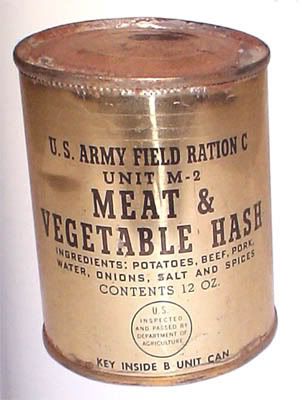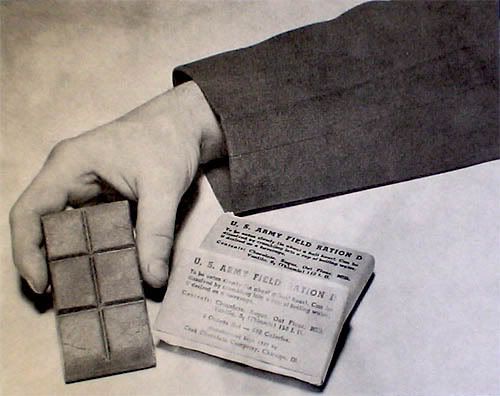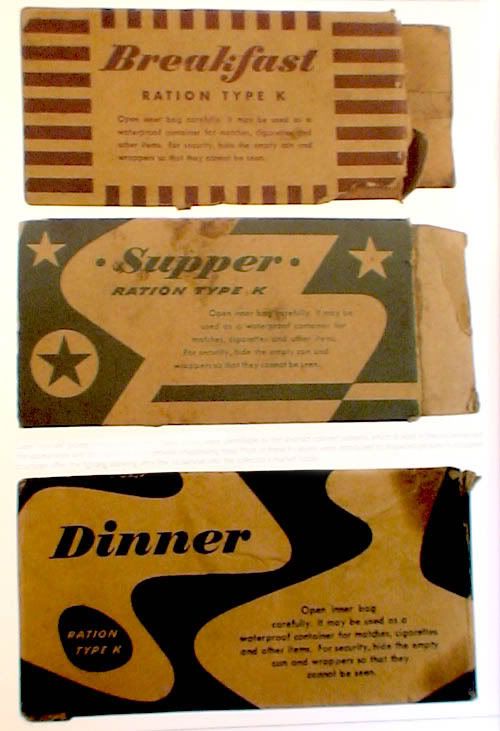|
|
Post by connie on Feb 6, 2009 0:33:30 GMT -5
Do you remember rations: what the packaging was like, when they were issued, what was palatable, what may have been hard to stomach... ? In the best of times meals were served only twice a day. Were rations ever issued to fill the gaps between?
|
|
Carl W.
Active Member
 Administrator
The Golden Lions
Administrator
The Golden Lions
Posts: 265
|
Post by Carl W. on Feb 7, 2009 7:52:36 GMT -5
Rations are fundamental to military operations. The US Army Quartermaster Corps, and equivalent units in all military services around the world, have to provide for the daily food needs of combat and support troops under all conditions. While cooked food served from field kitchens, or mess hall food at permanent bases, covers much of the need, many front line troops require special rations prepared and packaged for field use. The field rations developed from World War II through Vietnam were all replaced by the Meal, Ready to Eat (MRE) in the early 1980s or by more recent innovations such as the First Strike Ration. Army 5 in 1 RationsThe 5-in-1 ration introduced in 1942, and the later 10-in1, introduced in 1943, required minimal equipment to prepare and were designed to sufficiently feed up to five or ten men in the field per day. They included such items as meat products, vegetables, evaporated milk, fruit juice, soups, cereal, biscuits, hard candy, salt, sugar, toilet paper, cigarettes, matches, soap, towels, can openers and water purification tablets.  The C- Rations The C- RationsThe C ration or Combat Ration, with a caloric value of 3700, was intended for operational needs of three to twenty-one days. This ration resulted from pre-World War II attempts to produce a stable, palatable, nutritionally balanced combat ration which would provide the individual soldier with three full meals per day.  The D- Ration These were designed as both an emergency ration and supplement to other rations. These high-calorie semi-sweet chocolate bars were apparently very hard to bite.   The K- Ration The K- RationThis was designed as a lightweight ration, a complete compact packaged meal to be carried in combat. It came in three variants: Breakfast, Supper and Dinner. Each type included items as meat, cheese and crackers. Also various drink mixes, candy and cigarettes.   Any of you who have had to deal with these Army meals are free to give your comments and/or experiences. |
|
|
|
Rations
Feb 10, 2009 14:58:15 GMT -5
Post by bigjohn on Feb 10, 2009 14:58:15 GMT -5
I always remember Dad telling me that if he ever ran out of ammo, he could throw a D-bar at the enemy with similar results. Apparently they were so hard that there was no way to eat them in a half hour as the packaging states to do.
|
|
Carl W.
Active Member
 Administrator
The Golden Lions
Administrator
The Golden Lions
Posts: 265
|
Rations
Feb 10, 2009 15:56:15 GMT -5
Post by Carl W. on Feb 10, 2009 15:56:15 GMT -5
In various museums and private collections across Europe I have seen ground dug rations that were embedded in the earth for over 60 years. Strangly enough, the crackers that were part of the C-rations were still crackers. If they wouldn't dissolve after being buried for all that time, then I ask myself how a soldier could digest these things after eating them!!
|
|
|
|
Rations
Mar 7, 2009 10:40:13 GMT -5
Post by connie on Mar 7, 2009 10:40:13 GMT -5
I always remember Dad telling me that if he ever ran out of ammo, he could throw a D-bar at the enemy with similar results. Apparently they were so hard that there was no way to eat them in a half hour as the packaging states to do. I like your Dad's comments about the D-bar. Somewhere I remember reading that they did not have a positive effect on many digestive tracts and that some referred to them as "Hitler's secret weapon." I have found mention of Dad melting them in canned milk and making a drink he described as very rich-- a very small portion being filling... |
|
|
|
Rations
Mar 8, 2009 15:55:28 GMT -5
Post by floydragsdale on Mar 8, 2009 15:55:28 GMT -5
I vividly remember the "c" ration! The ones we had were bad & could make a GI sick if we ate them. Orders from Company Headquarters were "Don't eat them." Two of us had one apiece that we ate. The results were "We got the old fashioned back door trots." The front lines were not a good location to get something like that.
After that, we survived on "D" bars. Those bars couldn't be chewed at all; nor could they be melted. We would place those things on our helmets & hit them with something hard to break them; then put a piece in our mouth & let them dissolve. Several men from our company broke their false teeth on them & were sent to the rear (lucky them) to get new dentures.
Now and then someone would grab a "ten in one" ration off a tank when it went by, so we could have something to eat. When opened, the contents would be passed around. Once I spent several hours holding a can between my thighs to thaw it out. I waited several hours to find out that it was a can of ice-cold spinach, yet it tasted good. Things usually do when a person is hungry.
Floyd
G, Company 424th Regiment
|
|
|
|
Rations
Jun 30, 2011 17:30:56 GMT -5
Post by connie on Jun 30, 2011 17:30:56 GMT -5
|
|
|
|
Rations
Dec 4, 2013 13:02:24 GMT -5
Post by connie on Dec 4, 2013 13:02:24 GMT -5
|
|